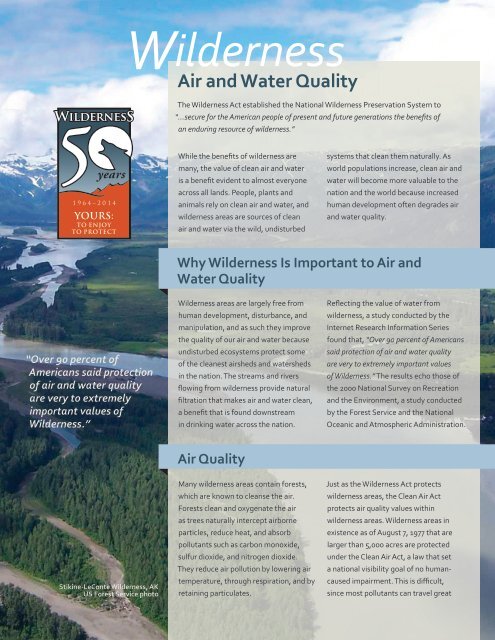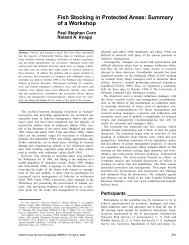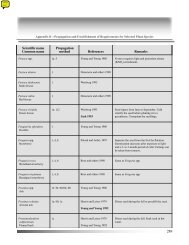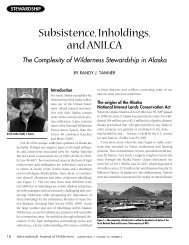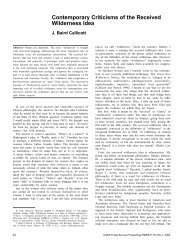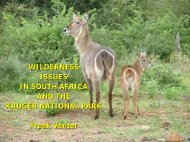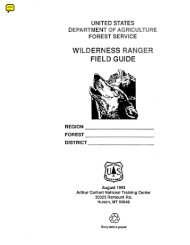Wilderness and Air and Water Quality - Wilderness.net
Wilderness and Air and Water Quality - Wilderness.net
Wilderness and Air and Water Quality - Wilderness.net
You also want an ePaper? Increase the reach of your titles
YUMPU automatically turns print PDFs into web optimized ePapers that Google loves.
<strong>Wilderness</strong><br />
<strong>Air</strong> <strong>and</strong> <strong>Water</strong> <strong>Quality</strong><br />
The <strong>Wilderness</strong> Act established the National <strong>Wilderness</strong> Preservation System to<br />
“…secure for the American people of present <strong>and</strong> future generations the benefits of<br />
an enduring resource of wilderness.”<br />
While the benefits of wilderness are<br />
many, the value of clean air <strong>and</strong> water<br />
is a benefit evident to almost everyone<br />
across all l<strong>and</strong>s. People, plants <strong>and</strong><br />
animals rely on clean air <strong>and</strong> water, <strong>and</strong><br />
wilderness areas are sources of clean<br />
air <strong>and</strong> water via the wild, undisturbed<br />
systems that clean them naturally. As<br />
world populations increase, clean air <strong>and</strong><br />
water will become more valuable to the<br />
nation <strong>and</strong> the world because increased<br />
human development often degrades air<br />
<strong>and</strong> water quality.<br />
Why <strong>Wilderness</strong> Is Important to <strong>Air</strong> <strong>and</strong><br />
<strong>Water</strong> <strong>Quality</strong><br />
“Over 90 percent of<br />
Americans said protection<br />
of air <strong>and</strong> water quality<br />
are very to extremely<br />
important values of<br />
<strong>Wilderness</strong>.”<br />
<strong>Wilderness</strong> areas are largely free from<br />
human development, disturbance, <strong>and</strong><br />
manipulation, <strong>and</strong> as such they improve<br />
the quality of our air <strong>and</strong> water because<br />
undisturbed ecosystems protect some<br />
of the cleanest airsheds <strong>and</strong> watersheds<br />
in the nation. The streams <strong>and</strong> rivers<br />
flowing from wilderness provide natural<br />
filtration that makes air <strong>and</strong> water clean,<br />
a benefit that is found downstream<br />
in drinking water across the nation.<br />
Reflecting the value of water from<br />
wilderness, a study conducted by the<br />
Inter<strong>net</strong> Research Information Series<br />
found that, “Over 90 percent of Americans<br />
said protection of air <strong>and</strong> water quality<br />
are very to extremely important values<br />
of <strong>Wilderness</strong>.” The results echo those of<br />
the 2000 National Survey on Recreation<br />
<strong>and</strong> the Environment, a study conducted<br />
by the Forest Service <strong>and</strong> the National<br />
Oceanic <strong>and</strong> Atmospheric Administration.<br />
<strong>Air</strong> <strong>Quality</strong><br />
Stikine-LeConte <strong>Wilderness</strong>, AK<br />
US Forest Service photo<br />
Many wilderness areas contain forests,<br />
which are known to cleanse the air.<br />
Forests clean <strong>and</strong> oxygenate the air<br />
as trees naturally intercept airborne<br />
particles, reduce heat, <strong>and</strong> absorb<br />
pollutants such as carbon monoxide,<br />
sulfur dioxide, <strong>and</strong> nitrogen dioxide.<br />
They reduce air pollution by lowering air<br />
temperature, through respiration, <strong>and</strong> by<br />
retaining particulates.<br />
Just as the <strong>Wilderness</strong> Act protects<br />
wilderness areas, the Clean <strong>Air</strong> Act<br />
protects air quality values within<br />
wilderness areas. <strong>Wilderness</strong> areas in<br />
existence as of August 7, 1977 that are<br />
larger than 5,000 acres are protected<br />
under the Clean <strong>Air</strong> Act, a law that set<br />
a national visibility goal of no humancaused<br />
impairment. This is difficult,<br />
since most pollutants can travel great
distances. To ensure preservation of air<br />
quality, the wilderness management<br />
agencies monitor air pollution that may<br />
impact flora, fauna, water, odor, visibility<br />
or cultural resources. Overall air quality is<br />
tested by monitoring visibility, rainwater,<br />
surface waters, <strong>and</strong> lichens.<br />
Some wilderness areas<br />
were designated in order<br />
to preserve healthy<br />
watersheds…<br />
<strong>Water</strong> <strong>Quality</strong><br />
Undisturbed ecosystems in wilderness<br />
have hydrological filtering effects that<br />
produce clean water. As such, many<br />
communities get their water from<br />
sources that start flowing in wilderness.<br />
According to the Forest Service, twothirds<br />
of the nation’s runoff, excluding<br />
Alaska, comes from forested areas,<br />
including wilderness, <strong>and</strong> 60 million<br />
Americans get their water from these<br />
watersheds.<br />
Large watersheds are composed of<br />
smaller watersheds, a fact that allows<br />
many communities to map their water<br />
source back to one or more wilderness<br />
areas. Fresno, California, for example,<br />
can map back its water source to the<br />
Sierra Nevada Mountains <strong>and</strong> many<br />
wilderness areas, such as the Yosemite,<br />
Ansel Adams, John Muir, Dinkey Lakes,<br />
Kaiser, Monarch, <strong>and</strong> Sequoia-Kings<br />
Canyon <strong>Wilderness</strong>es. Washington D.C.<br />
can map its water source back to within<br />
designated wilderness in Shen<strong>and</strong>oah<br />
National Park; Albuquerque, New Mexico,<br />
to Colorado’s Weminuche <strong>Wilderness</strong>.<br />
Some wilderness areas were designated<br />
in order to preserve healthy watersheds<br />
for current <strong>and</strong> future generations,<br />
such as the Rattlesnake <strong>Wilderness</strong><br />
just outside of Missoula, Montana. The<br />
Rattlesnake National Recreation Area<br />
<strong>and</strong> <strong>Wilderness</strong> Act of 1980 states<br />
that the “area has long been used as a<br />
wilderness by Montanans <strong>and</strong> by people<br />
throughout the Nation who value it as<br />
a source of...clean, free-flowing waters<br />
stored <strong>and</strong> used for municipal purposes for<br />
over a century.”<br />
The Great Swamp National Wildlife<br />
Refuge <strong>Wilderness</strong> in New Jersey<br />
exemplifies a wilderness area that was<br />
designated because it provides other<br />
water-related services including flood<br />
control, groundwater recharge, <strong>and</strong><br />
storm water detention <strong>and</strong> filtration.<br />
John Muir <strong>Wilderness</strong>, CA<br />
Photo by Greg Dusic<br />
<strong>Wilderness</strong><br />
<strong>Air</strong> <strong>and</strong> <strong>Water</strong> <strong>Quality</strong> 2


